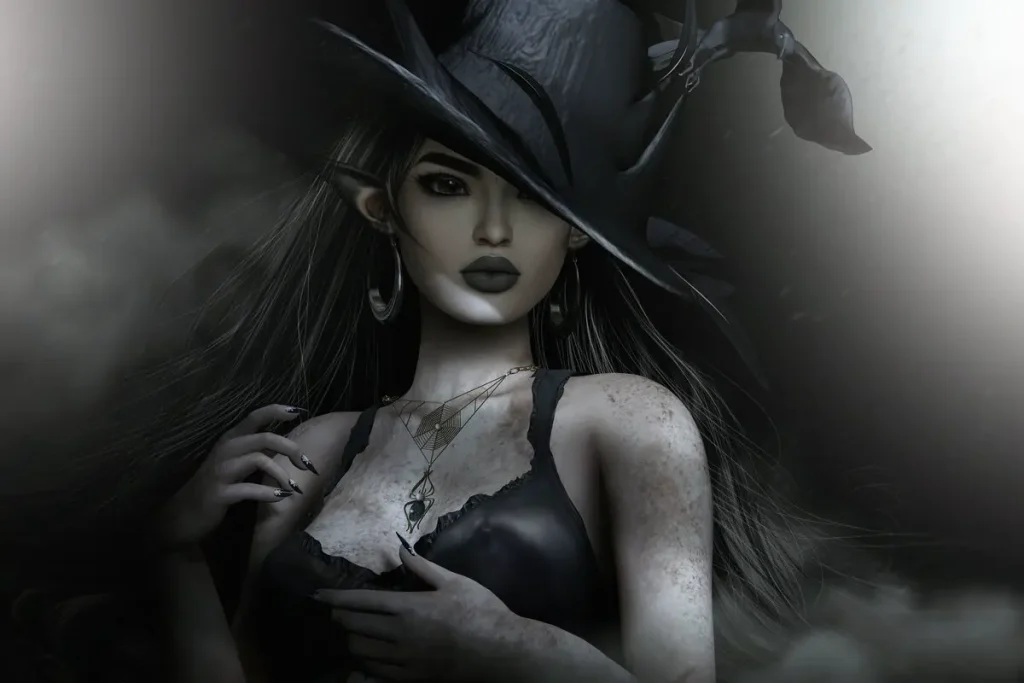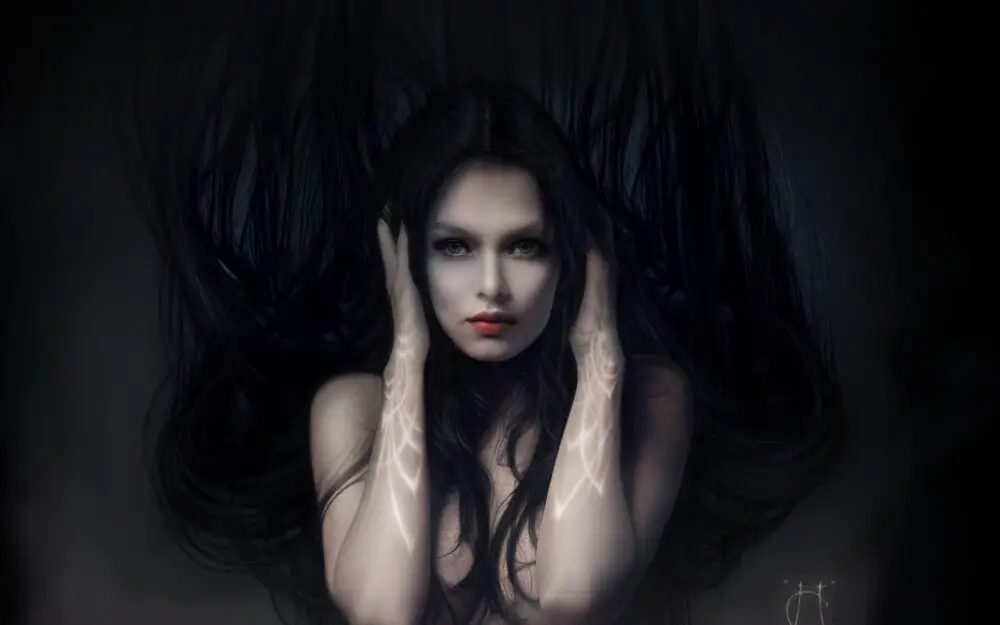Witchcraft, an ancient practice steeped in mystery and folklore, encompasses a rich linguistic tapestry that is often referred to as “witch language.” This unique language, filled with symbolism, incantations, and esoteric terminology, serves as a means of communication, ritual expression, and connection to the spiritual realms. In this article in Witch Symbols, we will embark on a journey to explore the fascinating world of witch language, delving into its origins, purpose, and the ways in which it enriches the practice of witchcraft.
The Origins of Witch Language
Ancient Roots:
The witch language finds its origins in ancient traditions, rituals, and beliefs that stretch back through the annals of time. From the shadows of prehistoric civilizations to the illuminated manuscripts of medieval Europe, witches and practitioners of the craft developed their own intricate systems of communication. These systems were not mere words and phrases but rich tapestries woven from the threads of mystery, magic, and ancient wisdom. Rooted deeply in the soil of history, these linguistic traditions served as conduits through which mystical concepts, secret knowledge, and potent spellwork were conveyed.
In ancient times, oral traditions were the lifeblood of mystical knowledge. Witches, shamans, and healers possessed a profound understanding of the power of language. Through spoken words and chants, they could call upon the forces of nature, beseech the gods, and commune with spirits. These linguistic nuances were not arbitrary; they were the keys to unlocking the hidden realms of existence. Passed down through generations like precious heirlooms, these linguistic legacies preserved the wisdom and power of the craft, ensuring that the knowledge of the ancients continued to thrive.
Folklore and Symbolism:
Witch language, a mesmerizing tapestry of words, phrases, and symbols, draws heavily upon the rich tapestry of folklore, mythology, and symbolism. It is not a random assortment of syllables but a carefully curated lexicon steeped in meaning and intent. Archaic words, passed down through centuries, carry echoes of ancient incantations, their resonance vibrating with the energy of countless generations of practitioners. Phrases, once whispered beneath the light of the moon, echo through time, connecting modern witches to their enigmatic ancestors.
Moreover, within the intricate lattice of witch language lies a symphony of symbols, each stroke and curve pregnant with significance. Runes, sigils, and glyphs, etched into ancient stones and parchment, serve as the building blocks of this cryptic language. These symbols are not arbitrary drawings but gateways to the subconscious mind, bridges between the material world and the ethereal realms. In the dance of symbols, practitioners find a universal language, one that transcends the barriers of spoken word, tapping into the collective consciousness of humanity. Through these symbols, witches commune with the energies they seek to invoke, their intentions taking shape in the metaphysical realm, guided by the eloquence of ancient symbols and the power of intention.
In the intricate interplay of ancient roots, folklore, and symbolism, the origins of witch language are woven. It is a language that speaks not just to the ears but to the very soul, a language that transcends time and space, uniting practitioners across generations in a sacred dance of words and witch symbols, where the mysteries of the universe are unveiled, and the power of the craft is reborn with every incantation.


The Purpose and Function of Witch Language
- Spellcasting and Incantations: The witch language, a mystical lexicon honed through centuries of practice, holds a pivotal role in the art of spellcasting and incantations. Within the sacred whispers of this language, specific words, chants, and rhymes are meticulously chosen, their syllables pregnant with intention and purpose. When spoken, they resonate with the energies of the universe, amplifying the practitioner’s will and focus. The rhythmic cadence of these incantations, akin to ancient hymns, creates vibrations that echo through the very fabric of reality. Through these carefully crafted linguistic symphonies, practitioners weave spells that transcend the mundane, invoking forces beyond the comprehension of ordinary language. The resonance of these words aligns the practitioner’s consciousness with the desired outcome, shaping reality with the power of intention.
- Secrecy and Protection: Deep within the heart of witch language lies the art of secrecy and protection. The crafters of ancient spells understood the value of safeguarding their knowledge, ensuring it remained a cherished secret passed down through generations. Witch language often incorporates coded or encrypted words and phrases, veiling the wisdom of the craft in layers of mystery. By speaking in a language not widely understood, practitioners maintain exclusivity and guard the sacred knowledge from those who might seek to misuse or exploit it. These encrypted utterances serve as a fortress, shielding the esoteric traditions from the prying eyes of the uninitiated, preserving the sanctity of the craft for those who truly honor its power.
- Connection to the Divine and Spiritual Realms: Witch language acts as a divine conduit, a bridge between the earthly realm and the infinite expanse of the spiritual dimensions. Through the sacred syllables and invocations, practitioners establish a profound connection with deities, elemental forces, and spiritual beings. Specific words and sacred names, uttered with reverence, resonate with the vibrational frequencies of the divine. In the echo of these words, practitioners find communion, guidance, and the channeling of energies during rituals and ceremonies. Through the language of the craft, they navigate the intricate tapestry of spiritual realms, invoking ancient wisdom and divine energies to empower their spells and ceremonies.
- Personal Empowerment and Transformation: Engaging with the intricate tapestry of witch language is not merely an act of linguistic expression; it is a transformative journey that empowers practitioners from within. As individuals immerse themselves in the study and utilization of this language, they develop a profound understanding of the symbolic significance of words, phrases, and gestures. Each syllable becomes a stepping stone toward personal growth and self-discovery. Through this understanding, practitioners tap into their intuition, embracing their inner power with newfound confidence. The language of the craft becomes a mirror reflecting their own potential, fostering a deep sense of spiritual empowerment. It is in this intimate dance with the language of witches that individuals transcend the mundane, embracing the extraordinary power within themselves and undergoing a profound metamorphosis, emerging as empowered, enlightened beings.
The Evolution and Modern Application of Witch Language
- Adaptation and Innovation: The witch language, much like any living language, has not remained stagnant in the flow of time. It has gracefully adapted to the changing tides of cultural and linguistic evolution. Modern practitioners of witchcraft are adept linguists, weaving ancient wisdom into the fabric of contemporary language. They ingeniously incorporate and innovate their linguistic traditions, infusing them with modern terminology, expressions, and nuances. In doing so, they breathe new life into the ancient words, making them relevant in the context of the 21st century. These practitioners, deeply rooted in tradition yet open to innovation, honor the past while embracing the ever-changing present, ensuring that the language of witches continues to evolve, vibrant and dynamic.
- Eclectic Influences: In the kaleidoscope of modern witchcraft, diversity reigns supreme. The contemporary witchcraft movement, open-hearted and inclusive, draws from a myriad of spiritual traditions, cultures, and languages. As a result, witch language has become a melting pot of linguistic influences, reflecting the rich tapestry of the craft. It is a language that knows no bounds, borrowing words, phrases, and symbols from different corners of the globe. In this eclectic fusion, the language of witches becomes a vibrant mosaic, each piece representing a different spiritual heritage, a unique perspective, and a diverse tradition. Modern witchcraft practitioners, in their exploration of diverse influences, celebrate the beauty of cultural exchange, creating a language that is not confined by geographical boundaries but is a testament to the global nature of the craft.
Examples of Ancient Words and Symbols Used in Witch Language
1. Runes: Runes are ancient symbols, often associated with Norse and Germanic traditions, used in witchcraft for divination, protection, and empowerment. Each rune carries a specific meaning and energy, making them powerful tools for practitioners. For example, the rune “Algiz” symbolizes protection and spiritual connection, while “Fehu” represents wealth and abundance.
2. Pentagram: The pentagram, a five-pointed star enclosed in a circle, has deep roots in various cultures, including ancient Mesopotamia and Greece. In book of witchcraft, it symbolizes the elements of Earth, Air, Fire, Water, and Spirit, representing the interconnectedness of these forces. It is often used in rituals for protection, banishing, and invoking elemental energies.
3. Ankh: The ankh, an ancient Egyptian symbol resembling a cross with a loop at the top, signifies life, immortality, and balance. Witches use the ankh as a representation of the life force and incorporate it into rituals related to healing, fertility, and spiritual transformation.
4. Ogham: Ogham is an ancient Celtic writing system consisting of a series of linear symbols, each associated with a specific tree or plant. In witchcraft, Ogham symbols are utilized for divination and communication with nature spirits. For example, the symbol “Beth” represents the birch tree and is associated with new beginnings and purification.
5. Sigils: Sigils are magical symbols created by combining letters from an alphabet or words into a unique design. Witches use sigils to represent their intentions and desires. By charging the sigil with energy, practitioners can manifest their goals. Sigils can be derived from ancient languages, such as Hebrew or Latin, or personalized using one’s native language.
6. Sanskrit Mantras: Sanskrit, an ancient Indic language, is revered in many mystical traditions. Witches incorporate Sanskrit mantras, sacred chants or words of power, in their rituals. Each mantra holds specific vibrations and meanings, making them potent tools for meditation, healing, and invoking spiritual energies.
7. Elder Futhark: Elder Futhark is the oldest runic alphabet used by Germanic tribes. Witches often incorporate these runic symbols in their spellwork. Each rune carries esoteric meanings and associations, allowing practitioners to tap into the runic energy. For instance, the rune “Thurisaz” represents protection, while “Ansuz” signifies communication and divine inspiration.
These ancient words and symbols serve as a link to the wisdom of the past, allowing modern witches to draw upon the knowledge and energy of their ancestors in their magical practices.
8. The Eye of Horus: The Eye of Horus, an ancient Egyptian symbol, represents protection, healing, and spiritual vision. It is associated with the god Horus and is believed to bring clarity, insight, and divine guidance. The symbol is often used in amulets, talismans, and rituals for protection against negative energies.
9. Triskelion: The triskelion is another common symbol in witch language, it is composed of three interconnected spirals or legs that radiate from a central point. It has ancient origins and appears in various cultures, including Celtic and Greek civilizations. The triskelion represents motion, cycles, and the interconnectedness of body, mind, and spirit. It is used for personal empowerment, spiritual growth, and invoking the energies of transformation.
10. The Triple Goddess Symbol: The Triple Goddess symbol represents the three aspects of the divine feminine: the maiden, the mother, and the crone. It is often depicted as three interlocking moons or as a triple moon symbol. This symbol is used in rituals, ceremonies, and personal reflections to honor the cycles of life, fertility, and the different stages of a woman’s life.
11. The Horned God: The Horned God symbolizes, in witch language, the masculine divine energy in witchcraft. It is often depicted as a figure with antlers or horns, representing wildness, nature, and the animal kingdom. The Horned God is associated with fertility, strength, and the cycles of nature.
Misconceptions about Witch Language
Witchcraft has long been surrounded by mystique and misconceptions, and the concept of a specialized “witch language” is no exception. Here, we unravel some common misconceptions associated with witch language, shedding light on the realities behind the myths:
1. Universal Witch Language:
- Misconception: Many people believe that there is a universal language spoken exclusively by witches worldwide.
- Reality: There is no single universal witch language. Practices and beliefs in witchcraft vary widely, and linguistic traditions differ among different cultures and traditions. Some witches may use ancient languages or symbols, but there’s no globally recognized language specific to all witches.
2. Secret and Incomprehensible Language:
- Misconception: Witch language is an obscure, secret language incomprehensible to outsiders.
- Reality: While certain symbols, words, and phrases are used in rituals, these are often based on historical languages or created by individuals and covens. They are not entirely secret; in fact, many resources are available for those interested in learning about them.
3. Evil and Malevolent Language:
- Misconception: Witch language is used exclusively for casting evil spells and curses.
- Reality: Witch language, like any language, can be used for both positive and negative purposes, depending on the practitioner’s intent. Many witches focus on healing, protection, and personal empowerment, using their language for positive and spiritual purposes.
4. Fixed and Unchanging Language:
- Misconception: Witch language remains unchanged over centuries, preserving ancient traditions exactly as they were practiced in the past.
- Reality: Witch language, like all languages, evolves over time. Modern practitioners often adapt and innovate their linguistic traditions to incorporate contemporary terms and expressions while honoring their roots. The language is dynamic and responsive to the evolving needs of its users.
5. Witch Language is Satanic:
- Misconception: Witch language is associated with Satanism or devil worship.
- Reality: Witchcraft and Satanism are distinct practices. While both may involve elements of the occult, they have different beliefs, symbols, and rituals. Witch language is not inherently Satanic and encompasses a wide range of spiritual traditions.
6. Witch Language Guarantees Power:
- Misconception: Speaking in witch language grants supernatural powers to individuals.
- Reality: Language alone does not confer supernatural abilities. Witch language is a tool, a medium for expressing intent and connecting with spiritual energies. True power in witchcraft comes from knowledge, experience, intention, and a deep understanding of the craft.
By dispelling these misconceptions, it becomes evident that witch language, like any language, is a multifaceted aspect of a diverse and rich spiritual tradition. It is a reflection of the beliefs, intentions, and creativity of the practitioners who utilize it, emphasizing the importance of understanding and respecting the diverse practices within the witchcraft community.


How to Use Witch Language in Practices
Using witch language in practices involves incorporating specific words, chants, symbols, and gestures to enhance the power and intention of rituals and spells. Here’s a guide on how to use witch language effectively in your magical practices:
Research and Understand: Familiarize yourself with the historical and cultural context of the words, symbols, and phrases you intend to use. Understand their meanings, origins, and the intent behind them. This knowledge will empower your practice and give depth to your rituals.
Set Your Intentions: Clearly define your intentions before performing any ritual or spell. Witch language amplifies your intentions, so knowing precisely what you want to achieve is crucial. Whether it’s protection, healing, empowerment, or manifestation, clarity of purpose is essential.
Choose Appropriate Words: Select words or phrases from languages that resonate with you or align with the tradition you are following. Many practitioners use ancient languages such as Latin, Greek, Hebrew, or Old English for their rituals. Alternatively, you can create your own words or phrases, imbuing them with personal significance.
Create Chants or Incantations: Craft chants or incantations using the chosen words or phrases. These chants should be rhythmic and melodic, making it easier to enter a trance-like state during rituals. Repeat them multiple times, allowing the sound and vibrations to fill the space and your being.
Utilize Symbols and Sigils: Integrate symbols and sigils from different magical traditions into your practices. These symbols represent your intentions and can be drawn on candles, talismans, or even in the air during rituals. Focus your energy on the symbols as you draw or visualize them, imbuing them with your intent.
Incorporate Gestures: Hand gestures, also known as mudras, can enhance the power of your spells. Each gesture holds a specific meaning and intention. For example, forming a circle with your thumb and index finger can symbolize unity and protection. Use gestures that align with your purpose to amplify the energy of your ritual.
Charge Your Tools: If you use magical tools such as crystals, wands, or athames, speak your intentions in witch language as you charge these tools with energy. Visualize the tools absorbing the power of your words, enhancing their magical properties.
Enter a Meditative State: Before chanting or performing rituals, enter a meditative or trance-like state. Focus your mind, clear away distractions, and center yourself. This heightened state of awareness allows you to connect more deeply with the energies you are invoking.
Practice Regularly: Like any skill, using witch language effectively requires practice. Engage in regular rituals, spells, and meditation sessions using your chosen words and symbols. With time and dedication, your proficiency in harnessing the power of witch language will grow.
Trust Your Intuition: While it’s essential to research and learn from established traditions, trust your intuition. If a specific word, phrase, or symbol feels right to you, incorporate it into your practice. Your intuition is a valuable guide in magical work.
Remember, witch language is a personal and intuitive practice. As you experiment and learn, you’ll discover what resonates most with your energy and intentions, making your magical practices even more potent and meaningful.
Final Thoughts
While the concept of a witch language continues to capture the imagination of many, it is essential to approach it with a critical and open mind. The rich tapestry of beliefs and practices within the witchcraft community is as diverse as the languages spoken across the globe. Instead of searching for a single, universal witch language, we should celebrate the diversity and creativity within the world of witchcraft. Embracing the mystery and exploring the unique ways in which individuals connect with the mystical can deepen our understanding of this ancient and enigmatic art.


Pingback: Decoding the Secrets of Witch Language: Whisper...